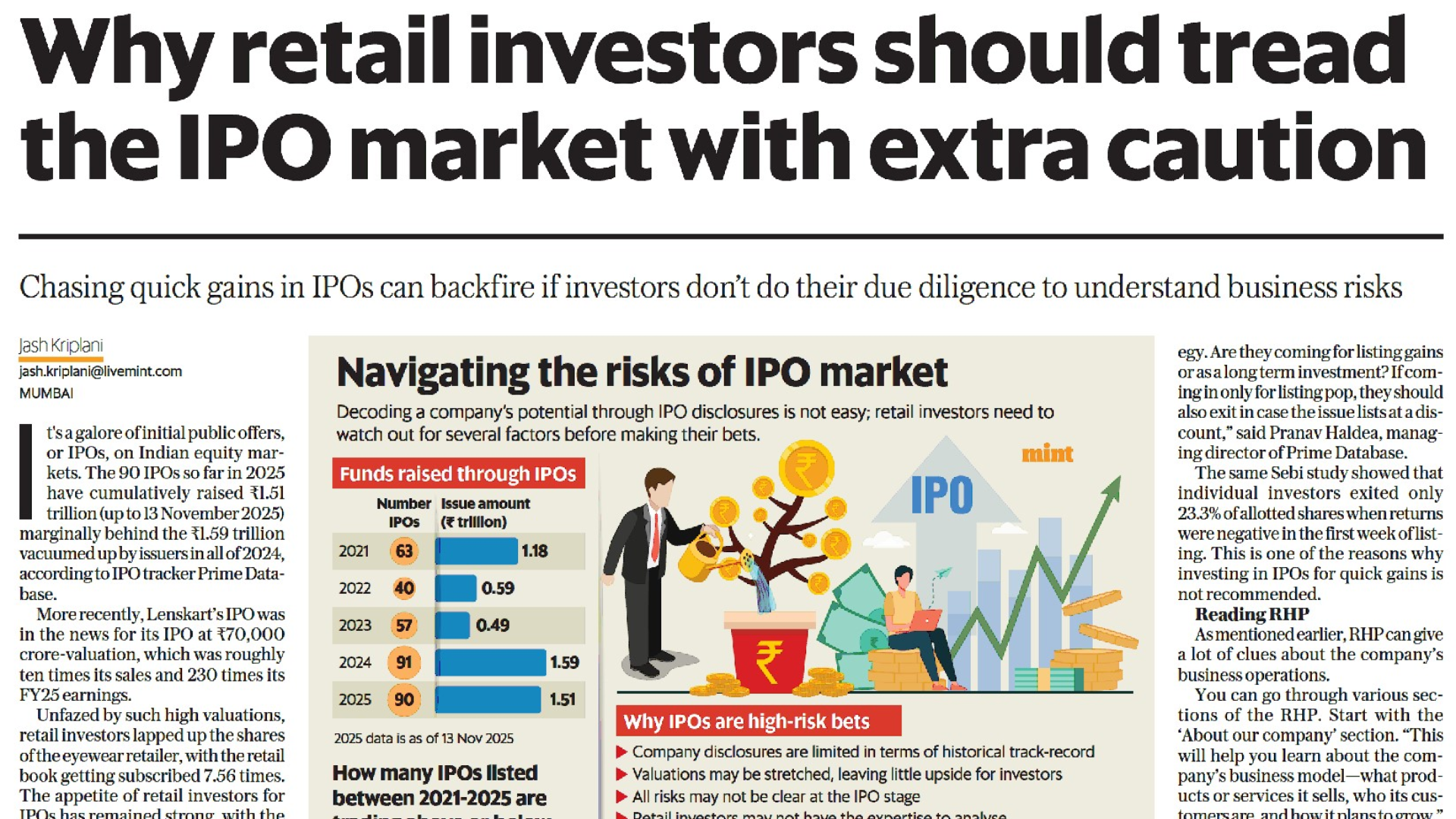Chasing Quick Gains in IPOs Can Backfire Without Proper Due Diligence
Chasing quick gains in IPOs can backfire if investors don’t do their due diligence to understand business risks.
It’s a galore of initial public offers, or IPOs, on Indian equity markets. The 90 IPOs so far in 2025 have cumulatively raised Rs 1.51 trillion (up to 13 November 2025), marginally behind the Rs 1.59 trillion vacuumed up by issuers in all of 2024, according to IPO tracker Prime Database.
More recently, Lenskart’s IPO was in the news for its IPO at Rs 7 offerings, a Rs 70,000 crore valuation, which was roughly ten times its sales and 230 times its FY25 earnings.
Unfazed by such high valuations, retail investors lapped up the shares of the eyewear retailer, with the retail book getting subscribed 7.56 times. The appetite of retail investors for IPOs has remained strong, with the average subscription of retail booksbeing about 24.28 times in 2025.
Such an appetite doesn’t, however, take away from the fact that IPO investing comes with its own set of risks. An issuer’s valuations may not align with how the market prices it after listing. Nearly two-fifths of IPOs between 2021 and 2025, for instance, are trading at below issue price, data from Prime Database shows.
Key risks may remain unclear, as the firm’s disclosure cycle has only just begun.
Thus, retail investors need to tread the IPO market with utmost care. Here is how you can use the company’s disclosures to take a more calculated risk when betting on an IPO.
What to Look For
Experts say retail investors should begin by examining the basics—valuation and business maturity. Deepak Jasani, an independent market expert, says most retail investors neither have the time nor the expertise to decode a company’s draft prospectus in depth.
“Start with simple metrics such as the price-to-earnings (P/E) and price-to-book (P/B) ratios and compare them with listed peers in the same industry. Metrics such as EV/EBITDA are slightly more complicated. Investors can find details of comparable peers in the company’s red herring prospectus (RHP),”
The RHP is required to be made publicly available. But there is a caveat—the RHP may compare the company with highly valued peers. Investors should also try and dig around on their own to see how other peers are valued.
For loss-making companies, traditional valuation metrics don’t work because earnings are negative. Analysts often turn to the EV/EBITDA multiple, as it focuses on a company’s operating performance. This helps gauge underlying earning potential even when net profits are yet to materialize. materialize.
Jasani adds that retail investors should remain conservative, even if it means missing some opportunities.
“Look for businesses with strong fundamentals. Check whether the business has a dividend distribution policy. The track record of dividends means that the company has gone over its big investment phase and can now partially share its profits with shareholders.”
Flipping Behaviour
Retail investors are often drawn to IPOs purely for listing gains. A study by SEBI found that 54% of IPO shares allotted were sold within a week (excluding anchor investors), based on IPOs between April 2021 and December 2023. Retail investors sold 42.7% of shares allotted to them within a week.
According to G. Chokkalingam, founder and head of research at Equinomics Research, even investors chasing listing gains must follow discipline:
“You may be keen to invest despite steep valuations, but limit your exposure. If the business lists at a discount, cut losses immediately. If there is a gain, book profits quickly.”
Pranav Haldea, managing director of Prime Database, agrees.
“Retail investors are inherently attracted to IPOs. But they must be clear about their strategy. If they come for the listing pop, they must also exit if the issue lists at a discount.”
SEBI’s study showed that investors exited only 23.3% of allotted shares when returns were negative in the first week—a sign of hesitation and loss aversion, which hurts outcomes.
Reading the RHP
The RHP (Red Herring Prospectus) provides crucial insights into a company’s operations.
Start with ‘About our ’company’—this section explains the business model, products, customers, and growth plans.
Next, go to ‘Financial information’:
“Look for steady revenue and profit growth over the past few years. Check commentary on expansion plans, geography additions, product launches, and customer acquisition strategy.”
Watch for red flags:
Profits but negative cash flows
High leverage
Frequent refinancing of loans
IPO funds used mainly for investor exit rather than growth or debt reduction
What Should Investors Do?
Investing in IPOs is riskier than buying already-listed stocks because:
Disclosures are limited
History is short
Financials cover just three years
If you lack research expertise, analysts suggest relying on mutual funds, which selectively participate in IPOs and diversify risk.
“Investing in IPOs is like navigating a maze,”
The safest route for retail investors remains —
a diversified mutual fund that invests in carefully selected IPOs.
Explore More Insights
For deeper expertise on IPO investing, valuation frameworks, and market behaviour, explore perspectives from
Ranjit Jha (CEO)—a leader in research-driven wealth advisory.
To understand how Rurash Financials supports investors through equity advisory, unlisted opportunities, and structured investment solutions, visit the official website.

